Frost-resistant onion “Batun” and features of its cultivation
You can often find spring onion in garden plots: its beautiful large lilac ball flowers decorate flower beds. Onions are grown for greens; their tall tubular feathers have a delicate, mild taste that is superior to ordinary green onions.
When to remove and how to store, what are the benefits and harms of onion, its photo, as well as other features - further in the article.
Description
Onion is a species of the genus Onion, grown as an annual or perennial plant. Its aerial part is a bunch of tall tubular feathers. Biologists call the base in the form of a short stem a false onion. The flowering of the batun occurs in the spring.
It is grown for its greens. Propagated by seeds and dividing the bush into individual bulbs.
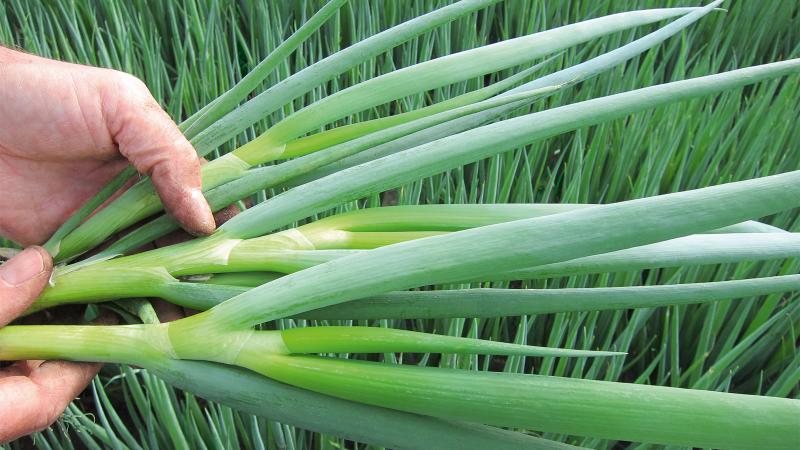
Varieties
Onion has a wide variety of varieties. Most often, early-ripening, high-yielding varieties are grown in open ground:
- April - one of the earliest varieties. The plant is resistant to low temperatures and diseases. From one bush you can get 40-45 arrows.
- Russian winter - grown before winter and spring. Tolerates the conditions of the northern regions of the country well.
- Tenderness - characterized by high productivity. The greens are tender, mild in taste, and contain large amounts of vitamin C and carotene.
- Emerald – an early ripening hybrid, resistant to cold temperatures, diseases and lodging. The taste is spicy.
- Red snowdrop - differs in frost resistance. The leaves are juicy and tender.
- Cipollino – an early variety with good resistance to diseases and pests. The leaves are succulent and slightly pungent.
Origin and development
Onion (Tatara, fistula, shortbread, Chinese onion) is a perennial herbaceous plant of the onion genus of the amaryllis family. Asia is considered the birthplace of onions. Grown in China and Japan. Currently, batun is cultivated in all regions of Russia, except the Far North.
Chemical composition and beneficial properties
The calorie content of onion per 100 g is 34 kcal. Also, 100 g of product contains proteins - 1.3 g, fats - 0.1 g, carbohydrates - 3.2 g.
Vitamin content:
- B1 – 0.05 mg;
- B2 – 0.09 mg;
- B4 – 5.31 mg;
- B5 – 0.17 mg;
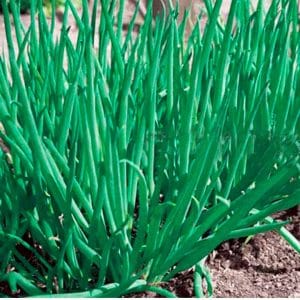
- B6 – 0.07 mg;
- B9 – 16.1 mcg;
- C – 27.1 mg;
- E – 0.52 mg;
- K – 192 mcg;
- RR – 0.41 mg.
Macronutrient content:
- potassium – 211 mg;
- calcium – 19 mg;
- magnesium – 22.5 mg;
- sodium – 17 mg;
- sulfur – 18.7 mg;
- phosphorus – 48 mg.
Microelements content:
- iron – 1.23 mg;
- manganese – 0.14 mg;
- copper – 71 mcg;
- zinc – 0.51 mg.
Onion is used for dietary nutrition, used in folk medicine for diseases of the digestive system, diseases of the cardiovascular system, colds, and to strengthen the immune system.
Batun is used as a diuretic, anthelmintic, and hemostatic agent. Onion pulp strengthens hair and is used as a mask for the face and hands.
Ripening time and yield
Batun is distinguished by its early ripening period. They begin to cut it 30 days after the first shoots appear.
Depending on the variety, the yield is 6.5-15.5 kg per 1 sq. m.
Disease resistance
The crop has a strong immunity to many diseases and pests, but if cultivation practices are not followed, downy mildew may appear on the feathers.
Characteristics, description of appearance, taste
The aerial part of the onion is tall, tubular, green feathers hollow inside. Their length reaches 60-80 cm, width 1-2 cm. At the base of the trumpet, a short stalk is formed, called a “false onion”; it is white, sometimes with a purple tint. The batun has no onion turnips. Batu is superior in taste to green onions; its flesh is more tender and milder in taste.
Onion blooms in spring with small lilac flowers collected in spherical inflorescences.
For which regions is it best suited and what are the climate requirements?
Batun is cultivated in almost all regions of the country with the exception of the Far North. Many onion varieties tolerate light frosts well.
Main advantages and disadvantages
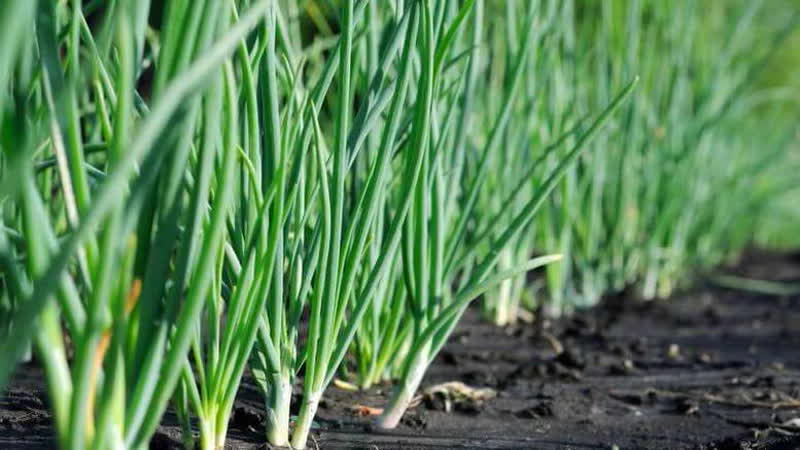
Onions have many advantages:
- this is a perennial, very productive crop: feathers can be cut up to three times per season;
- the opportunity to collect green feathers in early spring;
- low maintenance requirements;
- high productivity;
- has medicinal properties.
Disadvantages of the type:
- lack of onion;
- if you grow it for 4-5 years in one place, it will begin to become smaller, shoots will appear, and the taste characteristics will be lost.
What is the difference from other types of onions?
- batun feathers are more powerful and tall;
- the bush consists of several stems, each with 4-6 feathers;
- the bulb is undeveloped, thin;
- The batun is less demanding on lighting conditions; it can be planted in the shady part of the garden.
Features of planting and growing
Onions are grown in several ways: sowing seeds, planting seedlings in open ground, dividing the bush into daughter bulbs.
Preparing for landing
Before sowing, the seed material is soaked for two hours in warm water. During this time, high-quality seeds will sink to the bottom, unsuitable ones will float up and are thrown away.
Good seeds are disinfected in a solution of potassium permanganate for 30-40 minutes. Then they are placed in the refrigerator for hardening for a day. After this, the seeds are sown in a container with prepared soil.
Soil requirements
Batun grows well on turf, loamy, sandy loam soils with neutral or low acidity. To deoxidize the soil, wood ash is added, and chernozem is added to sandy soil.
Attention! To grow batun, do not use sandy or peaty soil. In such areas, the bow goes into the arrow.
In the fall, the site is dug up with the addition of organic matter and complex mineral fertilizers.
Dates, scheme and rules of planting
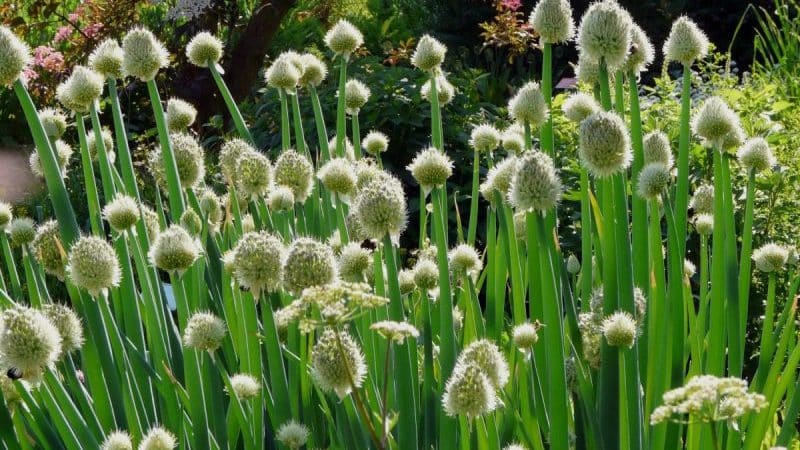
Seeds for seedlings are sown in the first half of April. The seeds are sown in a container with a substrate consisting of turf soil and humus (1:1), grooves are made 1 cm deep. 5 cm are left between them. The crops are covered with a small layer of soil, moistened with a sprayer, covered with film and placed in a warm place.
After the first shoots appear, the container is transferred to a well-lit place. For normal growth, they need 14 hours of daylight, so they will need lighting.
Seedlings are periodically moistened. Two weeks after the emergence of seedlings, they are fed with a solution consisting of 1 g of potassium nitrate, 1 g of superphosphate, 5 liters of water. When the first true leaf blade appears, the seedlings are thinned out, leaving a distance of 3 cm.A week before planting in open ground, seedlings are hardened by placing them in fresh air with a gradual increase in hardening time.
In mid-June, seedlings are planted in open ground. In the prepared area, grooves are made 3-4 cm deep, the plants are planted at a distance of 3 cm, and a gap of 20-25 cm is left between the rows.
Features of cultivation
Onions are grown only for greenery. When grown as a perennial plant, the harvest can last for five years.
Nuances of care
At the end of June, the lower feathers are trimmed. The young top greens are left for further growth.
To transplant an onion to a new place, it is dug up, the bulbs are divided into several pieces and planted separately in a new place.
Reference. In autumn, the batun does not need care, as it goes into the sleep stage.
Watering mode
Watering the crop should be carried out regularly and abundantly. The soil is moistened to a depth of 18-25 cm. In dry weather, the beds are watered twice a week. If dry weather persists for a long time, the crop is watered every other day with warm water at the root.
Important! When growing spring onions, drying out of the soil is unacceptable.
Loosening the soil and weeding
After each watering, the soil is loosened to prevent the formation of an earthen crust and to provide air access to the roots. Weed the plantings as weeds appear, preventing the normal growth of onions.
Top dressing
The first feeding of seedlings is carried out 10 days after planting in open ground, using organic matter: wood ash, compost, chicken manure solution.
Important! Feeding with chicken manure is carried out once, since onion greens accumulate nitrates.
The second feeding is carried out after three weeks. 20 g of Nitrophoska per 1 sq.m. is added to the soil. m.
During the period of green growth, onions need potassium and phosphorus. Potassium nitrate (15 g per 1 sq. m) and superphosphate (20 g per 1 sq. m) are added to the soil. Feeding is carried out three weeks after the second.
Disease and pest control
Batun is an unpretentious plant, but if agricultural cultivation techniques are violated, fungal diseases may appear on it.
Downy mildew (peronospora) - manifests itself in the form of a gray-violet coating on the green mass, leading to the death of the affected areas. High humidity should not be allowed in the beds - this is what provokes its appearance. In advanced cases, onions are sprayed with a solution of copper sulfate.
Attention! Chemicals are used only in extreme cases.
Rust - manifests itself in the form of rusty spots on the feathers, taking the form of knobs. At the first signs of illness, dusting with chalk is used. For severe lesions, spray with Fitosporin-M, 1% Bordeaux mixture.
White rot - begins as a white coating at the base of the stem. Then it spreads to the leaves, leading to their death. For treatment, plants are treated with the following composition: 3 g of copper sulfate, 10 g of carbamide (urea), 1 g of zinc, dissolved in 10 liters of water.
Insects often appear on the trampoline -pests: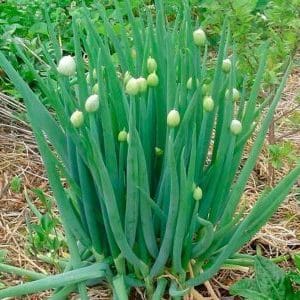
- Stem nematodes - small white worms that live inside feathers and feed on their juice. A sign of the appearance of nematodes is colorless spots on the feathers. For prevention, plants are sprayed with infusion of garlic, tomatoes, and potato tops.
- Onion fly larvae — parasitize in the false bulb, eat away the core. Feathers turn yellow and fade. For onion flies, treatments are carried out three times a season with a saline solution (a glass of salt per 10 liters of water).
Harvest and storage
Cutting of greenery begins in the second half of July and continues until autumn. When grown for many years, feathers begin to be trimmed in the spring, a month after the appearance of green shoots.
Reference. The sooner the first greens are cut, the sooner the second harvest is harvested.
The last pruning is carried out a month before the onset of frost.
How and when to collect
Final cleaning is carried out in the fall. When the feathers reach a height of 23-25 cm, they are cut off at the level of the soil surface. The bulb is not pulled out - it is left in the soil for further growth in the spring. Cut greens are tied into bunches, wrapped in cling film and placed on storage.
Storage features and shelf life
For long-term storage of onions washed, cut, packaged in bags, containers and placed in the freezer. At the same time, greens do not lose their nutritional value for about a year.
Onions are stored in the vegetable compartment of the refrigerator for about a month, maintaining their presentation and taste.
Dried onions have a long shelf life. To do this, it is cut, dried, then placed in paper bags and stored in a dry place. Dried baton is used as a seasoning for culinary products.
What difficulties may there be when growing
Onion does not tolerate low-lying areas where water accumulates after rains. At the same time, the soil should be constantly slightly moist during cultivation. Therefore, it is necessary to choose the correct watering regime for the full growth of the crop.
Advice from experienced gardeners
Experienced gardeners note that when plantings are dense, plants cannot develop fully. But if you reduce the distance between the bushes to 5 cm, the green feather will be a little thinner and more delicate.
Experienced summer residents advise planting batun in an area where legumes, cabbage, and tomatoes previously grew. It is not recommended to plant the crop after garlic, cucumbers, and carrots.
Experienced gardeners recommend covering the area with onions with film for the winter - in the spring you can get the harvest two weeks earlier.
Reviews about onion
Most reviews about onions are left by housewives who use them as a seasoning.
Elena, Moscow region: “A neighbor shared a freshly cut bunch of onions. I was surprised by its taste - completely different from ordinary green onions, soft, tender, without bitterness. I liked it very much."
Oleg, Saratov: “I’ve been growing trumpet for several years by dividing the bushes. From spring to autumn I constantly cut off fresh feathers for food; new ones grow quickly. Onions grow without problems and do not require special care.”
Maria, Omsk: “Out of interest, I purchased onion seeds at a reasonable price - 5 rubles. per pack. I sowed it in the spring, and two months later it was already planted with the delicate, unusual taste of feathers. I noticed that if you regularly cut the feathers, they don’t become coarser.”
Conclusion
Onion onions are gaining increasing popularity among summer residents and farmers due to their unpretentiousness and ability to grow in different climatic conditions. Onion greens eaten from early spring to autumn.
The beneficial properties of batun are due to its rich composition. This type of onion is widely used in folk medicine and cosmetology.